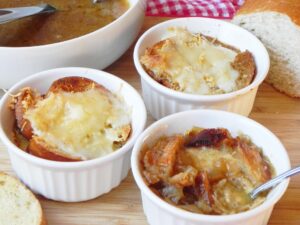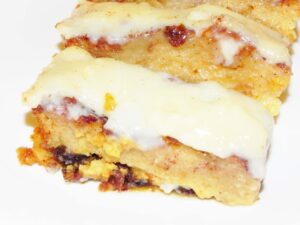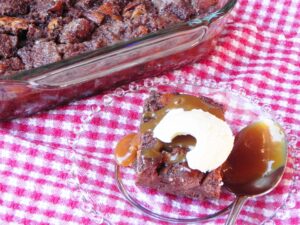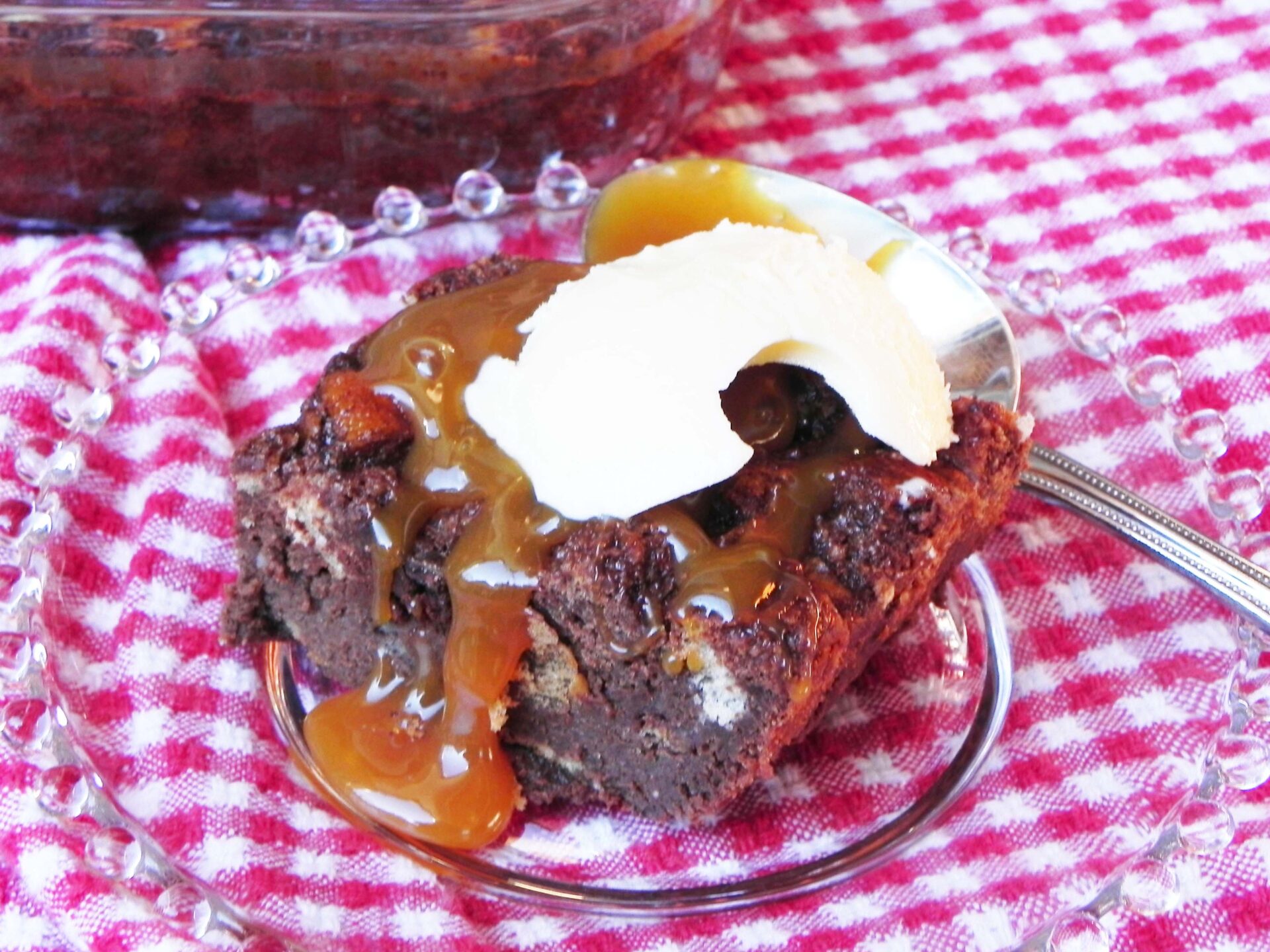Eating Oxford
On Cooking Southern: Bread Pudding and French Onion Soup
By Laurie Triplette
ldtriplette@aol.com
SOUTHERNISM OF THE WEEK
Bread and butter: A universal American expression having several definitions, according to usage… (1) One’s basic livelihood, presumably the means for buying the bread and butter staples for survival (related to the expression which side is your bread buttered on, which refers to the source of one’s livelihood); (2) anything that has been melded together in such a way that it cannot be separated; (3) a superstition-based expression uttered when two people are walking together and have to split to walk on either side of an obstruction such as a pole or tree.
LET’S GET BACK TO BASICS
Americans’ culinary taste preferences and habits have evolved significantly since our forebears’ reliance on homegrown grains, dried beans and fruits, and salt-cured meats. Improved household wealth and mass food distribution have made this possible. By the turn of the new century, the very sources of our food supply had become an obscure concept for the majority of our population.
Traditional American eating habits were based on what we could grow, gather, or hunt, what we could preserve from our efforts, and how we could repurpose the leftovers in combination with cupboard staples. Money was always tight when America was an agrarian nation. Nowhere in the United States was this more evident than across the South, whose multicultural populations comingled their foodways during the process of surviving natural disasters, wars, recessions, and the shift away from farming to manufacturing.
A recent study based on the 2010 U.S. census showed that only 16 percent of Americans still reside in rural areas, and a much smaller demographic still live on working farms. This is a decline from 21% of the population living on farms as recently as 1995. These statistics are shocking to those of us who grew up on farms, or only one generation removed from the farm. They are even more shocking when comparing our cultural shift since the early 20th century (1910), when more than 72% of the American population lived on farms.
Sociologist Robert Lang (University of Nevada at Las Vegas) and Brookings Institute demographer William Frey have provided recent calculations that supplement these 2010 U.S. census statistics. The latest data confirm that vast rural areas are losing population as young people leave for suburbs and cities where they can find jobs. The most significantly affected areas include the Great Plains, Arkansas, Appalachia, and Mississippi (the Delta, etc.).
There is a universal negative economic fallout from this population shift away from the rural areas into suburbs and cities. It is the root cause for consolidation of airline routes (leading to deletion of hubs), closings of U.S. Postal Service branches in rural areas, and closings of schools in areas with diminished populations. Sound familiar? Diminished rural populations have contributed to declines of entire rural villages across the South.
At the same time, some experts predict that the next big cultural trend is to urban farming. The emergence of community gardens and municipal farmers markets supports this trend in areas where “urban food deserts” once proliferated, particularly in poor communities.
These demographic shifts, coupled with the outfall of the 2008-2010 Great Recession, have coincided with an American culinary renaissance. Younger adults, reared in working households where parents did not cook, are clamoring to learn more about where our food comes from, how to cook more healthfully, and how to be financially smart when making food choices.
Where am I going with this information? One of The Old Bride’s goals for 2014 is to re-examine classic recipes from the early to mid-20th century, when Southern cooks had high aspirations but limited pocketbooks and even more limited culinary resources. I intend to identify which recipes still have merit in our fast-paced 21st Century society, where we have access to a world of exotic ingredients, but little time and limited budgets. I suspect that in many instances we will find that Mother knew best, or at least knew a good thing or two … except perhaps regarding gelatin.
This week we will share some yummy bread pudding dessert recipes and a sure-fire French Onion Soup recipe that can be rustled up to add a touch of elegance to a winter table. What a terrific way to keep those New Year resolutions to stay on a budget and eat more simply!
Bread Pudding and its Ingredients
Bread Pudding as a named dish originated in the 11th century as a logical way to use stale bread. Originally known as “poor man’s pudding,” it has been elevated over the centuries.
Check 20th century community cookbooks from every Southern state and you will find at least one bread pudding recipe in each. Many of the bread puddings include “Hard Sauce” topping made with rum or bourbon. The more daring of the recipes featured chocolate bread pudding. Over the years, eccentrics in each of our regions have devised versions incorporating their favorite bread-based grain. The sky’s the limit, and the more recent ones are connected to regional bread products. Think Krispy Kreme Bread Pudding… Sister Schubert Cinnamon Roll Bread Pudding…
When comparing dozens of bread pudding recipes, I found that most early to mid-20th century versions contain evaporated milk and water, although some also call for cream, whole milk, or half and half. The history of evaporated (canned) milk explains why: During the 19th and early 20th century, evaporated milk, which was pasteurized, was safer and with much longer shelf life, than most commercially sold milk.
Although first condensed in France in 1820, it was in 1853 that an American, Gail Borden, Jr., began condensing milk for commercial sales. He also instituted the now-required dairy practice for farmers to wash their cows’ udders, and to sterilize their milk containers morning and night. Borden added sugar to the condensed milk because sugar is a bacterial retardant. It was used extensively by Union troops during the Civil War. Sweetened condensed milk, also known as condensed milk, is not generally interchangeable with evaporated milk because of the high sugar content.
In 1885, Swiss immigrant John Meyenberg received a patent for canning unsweetened evaporated milk. He began marketing unsweetened canned milk in 1890 through his Helvetia Milk Producing Company, which later became Pet Milk. Canned evaporated milk took off commercially after Elbridge Amos Stuart developed a process for sterilizing the canned milk, and collaborated with Meyenberg. Evaporated milk was heavily fortified with additional vitamins from its inception, and in 1934, Pet Milk Co. developed a process for irradiating the milk to add Vitamin D.
Evaporated milk is an excellent ingredient for puddings and sauces and crock pot recipes because it can withstand high heat temperatures without curdling, unlike fresh milk. I have compared my bread pudding recipes containing evaporated milk against recipes containing fresh milk and cream. My preference is for the evaporated milk versions because of the creamy denseness of the finished pudding.
French Onion Soup Ingredients
Everyone who has ever heated anything on the stove knows that an onion can be the root of all things tasting good. When sautéed in butter or olive oil, onions caramelize as they darken, turning the flavor from pungent to amazingly sweet. French onion soup depends on this process to transform a yeoman vegetable bulb into a food star. The classic French onion soup loved by Americans since the 1960s is the version Julia Child introduced to us as “Soup a l’Oignon Gratinee.” It consists of caramelized onions boiled with beef stock and topped with bread and melted cheese.
Until a few years ago, creating homemade French onion soup was a laborious project simply because one had to make beef stock by baking, scraping and boiling beef marrow bones. Those bones are scarce nowadays.
Several soup manufacturers have begun marketing containers of beef stock that do not contain MSG and other offending artificial ingredients. The Old Bride has found this packaged product to be perfectly adequate as a substitute for homemade beef stock. Moreover, jars of concentrated beef base are now available and a spoonful of beef base is much better for deepening the flavor than old-fashioned beef bouillon cubes. I don’t bother.
FRENCH ONION SOUP
This soup is so easy, I highly recommend adding it to your standard recipe repertoire for company dinners.
1 lb (approximately 6) white onions
4 to 8 T salted butter
2 (26-oz) containers of beef stock or broth, or beef AND chicken broth
 1/4 tsp fresh ground black pepper
1/4 tsp fresh ground black pepper
1/4 tsp salt
6 slices French bread
2 T butter
Garlic powder
1 c grated or shredded Parmesan cheese
Splash of cognac or sherry, optional
Slice onions about 1/8 inch thick. Sauté in large saucepan in butter until browned but not burned. Cover, and stir occasionally until onions have become caramelized and golden (about 20 minutes). Season with the pepper and salt. Stir in the stock broth (beef or beef and chicken). Simmer on medium-low heat about 30 minutes until broth reduces by about a third. Add optional splash of cognac or sherry during this stage. (Try making it without the booze when you make it the first time, then judge.)
While the soup is simmering, slice bread into slices about 1/4-inch thick. Slather each slice with softened butter or olive oil and sprinkle with garlic powder. Toast the slices until crisped in preheated oven set at 350˚F.
Ladle soup into individual ramekins or a single large casserole. Top with the toasted French bread. Sprinkle generous amounts of shaved Parmesan over the toast. Bake until cheese is melted. Serve at once. Break up the cheese-toast into the soup. YIELD: About 10 (7-oz) individual ramekins.
VARIATION: Boil some carrots and celery in the beef stock and remove them before adding stock to caramelized onions.
RUMMY BREAD PUDDING
 VERY RICH! This is my take on classic bread pudding. I always add raisins because my conscience won’t allow me to consume bread and butter and sugar without some diet-redeeming fruit in the mix. Of course, soaking the raisins in rum first adds a desired touch of decadence. Although challah or a similar brioche bread works best, I have found that our Oxford Kroger offers a great substitute — a two-pack of sweet Italian baguettes.
VERY RICH! This is my take on classic bread pudding. I always add raisins because my conscience won’t allow me to consume bread and butter and sugar without some diet-redeeming fruit in the mix. Of course, soaking the raisins in rum first adds a desired touch of decadence. Although challah or a similar brioche bread works best, I have found that our Oxford Kroger offers a great substitute — a two-pack of sweet Italian baguettes.
Pudding:
1 stick butter (8 T)
1-1/2 c white granulated sugar
3 eggs
12-oz can of evaporated milk
3 oz skim or whole milk
4 c stale French or Italian bread, cubed
1 T vanilla extract
1 c raisins (black or golden)
2 T white rum
2 T sugar
1 tsp cinnamon
1/2 tsp nutmeg
Rum Sauce Topping:
12 oz whole or skim milk
12-oz can sweetened condensed milk
2 T cornstarch dissolved in 2 to 4 T water
3 T butter
1 T sugar
1 to 3 oz white rum
Preheat oven to 350˚F. Grease a deep 8-1/2 or 9-inch casserole baking dish with nonstick cooking spray or butter. Soak the raisins in 2 T of rum in a small bowl for about 10-20 minutes. Melt the butter in the microwave and pour into a mixing bowl. Beat with first sugar. Mix in the eggs, one at a time. Mix in the milk until completely blended, and add vanilla.
Fold in the bread cubes and stir vigorously. Press and mash, and stir until the bread has become mushy and cubes no longer defined. Stir in raisins last and spread evenly in a prepared baking pan, OR wait and fold raisins into the batter once the pudding has been spread in the pan (the raisins will all fall and make a layer in the bottom of the pan if mixed into the batter).
Combine the cinnamon, second sugar, and nutmeg, and sprinkle evenly across top of pudding. Bake about 20 minutes, until firm in center.
While pudding is nearing completion, heat the cup of milk and butter in a medium saucepan. Whisk in the sweetened condensed milk and the dissolved cornstarch (should be runny rather than thick), continuing to whisk and stir to prevent scorching, which can occur quickly because of the condensed milk sugars. Stir in last sugar and continue stirring or whisking gently until thickened. It will set up suddenly.
Remove from heat and whisk in rum. Set aside until the pudding comes out of oven. Spread the sauce topping evenly across the hot pudding. It is not necessary to use ALL the sauce as long as it completely covers the top of the pudding. Allow pudding to cool. Slice and serve. Refrigerate unused portion. Yields 15 to 20 small servings.
DEEP CHOCOLATE BREAD PUDDING
 This version is extremely rich and dark. Tastes best served hot with ice cream and coffee. For a sweeter and lighter version, use the smaller amount of chopped semisweet chocolate; feel free to include some milk chocolate chips. If reducing the chocolate amount, increase the sugar amount. For a creamier, pudding-like version, remove crusts before cubing bread. Pudding made with cubes containing crust sets up more like a decadent brownie cake.
This version is extremely rich and dark. Tastes best served hot with ice cream and coffee. For a sweeter and lighter version, use the smaller amount of chopped semisweet chocolate; feel free to include some milk chocolate chips. If reducing the chocolate amount, increase the sugar amount. For a creamier, pudding-like version, remove crusts before cubing bread. Pudding made with cubes containing crust sets up more like a decadent brownie cake.
6 to 7 c cubed French or Italian bread
1 stick (8 T) butter
12-oz can of evaporated milk
5-oz can of evaporated milk
3/4 c half and half or whipping cream combined with skim milk
3 eggs
3 egg yolks
1 tsp vanilla extract
Pinch of salt
2 T white granulated sugar
8 to 16 oz semisweet chocolate, chopped
1 to 2 T additional white granulated sugar
Melt butter in microwave. Place bread cubes in large bowl and add melted butter. Use hands to toss and coat all the cubes. Place buttered cubes into a buttered 9-by-13-inch baking pan. In a large saucepan, heat the milks to a simmer, remove from heat. Whisk in the chocolate until melted and smooth. Set aside to cool on rack.
Whisk the eggs, yolks, and first sugar in a separate bowl until frothy. Whisk the chocolate mixture again to accelerate the cooling and remove chocolate bits from bottom of the pan. Temper the egg mixture with about a tablespoon of the cooled chocolate mixture. If still lukewarm, whisk the chocolate mixture vigorously, and add a few more tablespoons to the egg mixture while whisking the eggs.
While whisking, pour the remaining chocolate mixture into the eggs in a steady stream. Whisk until completely blended. Pour over the bread, mash the bread down to completely coat with pudding. Loosely cover pan and allow to sit at room temperature for about 20-30 minutes, or in fridge if the room temperature is hot. The key is to allow the egg-chocolate mixture to saturate the bread cubes.
Just before baking, preheat oven to 350˚F. Sprinkle 1 to 2 T of sugar evenly across the top (this will result in an attractive glaze once baked). Bake on middle rack for 35 to 45 minutes, until pudding is set in the center. Remove to rack to cool enough for pudding to set up. Serve warm or cool with a caramel sauce and whipped cream or ice cream. Refrigerate leftovers.
(BOURBON) CARAMEL SAUCE
Caramel sauce is slightly different from caramel syrup, in that it contains cream and often contains corn syrup. Caramel syrup usually consists solely of caramelized white sugar and water, although brown sugar may be used. Our friends in Kentucky are very fond of adding this boozy iteration of caramel sauce to their bread puddings. Feel free to omit the alcohol or to substitute a different booze more to your taste, such as Kahlua, rum, Irish Whiskey, or brandy.
2 c white granulated sugar
1/2 c water
1 T light corn syrup
1 c heavy whipping cream
1 T up to 1/4 c bourbon or comparable liquor
Combine sugar, water and corn syrup in a medium saucepan. Bring mixture to a boil on medium heat. DO NOT STIR. Cook until the sugar has dissolved, washing down sides of the saucepan with a wet pastry brush. Continue simmering without stirring about 6 more minutes, until the mixture turns into an amber caramel. Remove pan from heat and gently stir in the cream with a wooden spoon. Stir in the booze, for about a minute until completely blended. Set aside on a rack or back burner to cool completely. Transfer caramel to a clean dish, jar or bottle. Store covered in fridge when not using. The caramel sauce may be heated in a warm water bath before serving.
Laurie Triplette is a writer, historian, and accredited appraiser of fine arts, dedicated to preserving Southern culture and foodways. Author of the award-winning community family cookbook GIMME SOME SUGAR, DARLIN’, and editor of ZEBRA TALES (Tailgating Recipes from the Ladies of the NFLRA), Triplette is a member of the Association of Food Journalists (AFJ),Southern Foodways Alliance (SFA) and the Southern Food and Beverage Museum (SOFAB). Check out the GIMME SOME SUGAR, DARLIN’ web site: www.tripleheartpress.com and follow Laurie’s food adventures on Facebook and Twitter (@LaurieTriplette).































